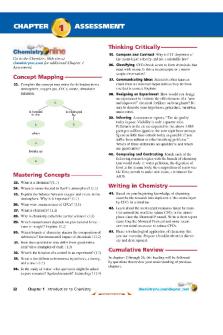Part 1 PDF

| Title | Part 1 |
|---|---|
| Author | Shivani Lata |
| Course | Financial Accounting |
| Institution | The University of the South Pacific |
| Pages | 2 |
| File Size | 61.7 KB |
| File Type | |
| Total Downloads | 65 |
| Total Views | 165 |
Summary
Assignment part 1...
Description
Explain the main reasons why IASB issued the new or revised standard IFRS 13 (Fair Value Measurement) was introduced and adopted on 13th May 2011 (with the effective date being 1st January, 2013) by the US Financial Accounting Standard Board and International Accounting Standard Board. IFRS 13 therefore defines Fair Value as "the price that would be received to sell an asset or paid to transfer a liability in an orderly transaction between market participants at the measurement date". This definition clarifies that Fair value is an exit price; there is an orderly sale or transfer and that fair value is a market-based measurement and entity-specific concept (Dvorakova, n.d). IFRS 13 according to IFRS Foundation (2013) was introduced purposely to reduce the discrepancy in details about the treatment of fair value accounting valuations, clarifying measures and disclosure targets, reducing the ambiguity of fair value definitions in a move to make them simpler to expected users. IFRS 13 has also been implemented to improve the criteria for disclosure of equal value assessments, which would of course improve transparency. The purposed benefits of IFRS 13 stated above are presumed to provide investors with more information to base their decisions. The previous version of the Conceptual Framework included little guidance on measurement. The revised Conceptual Framework describes what information measurement bases provide and explains the factors to consider when selecting a measurement basis. The revised standard for Fair value measurement reflects the factors such as (a) Estimates of future cash flows. (b) possible variations in the estimated amount and timing of future cash flows for the asset or the liability being measured, caused by the uncertainty inherent in the cash flows. (c) The time value of money. (d) The price for bearing the uncertainty inherent in the cash flows (ie a risk premium or risk discount). The price for bearing that uncertainty depends on the extent of that uncertainty. It also reflects the fact that investors would generally pay less for an asset (generally expect to receive more for taking on a liability) that has uncertain cash flows than for an asset (liability) whose cash flows are certain. (e) Other factors, such as liquidity, that market participants would take into account in the circumstances.
https://www.iasplus.com/en-ca/projects/ifrs/completed-projects-2/ifrs-13-fair-value-measurement https://www.iasplus.com/en-ca/projects/ifrs/completed-projects-2/ifrs-13-fair-value-measurement https://www.aasb.gov.au/admin/file/content105/c9/ACCED264_06-15.pdf https://search-proquest-com.ezproxy.usp.ac.fj/docview/2025303231/5BE2BDAD25924845PQ/2? accountid=28103
Table IFRS 13 — Fair Value Measurement. (2020). Retrieved 6 April 2020, from https://www.iasplus.com/en/standards/ifrs/ifrs13...
Similar Free PDFs

Part 1
- 2 Pages

Module 1 - Assessment Part 1
- 2 Pages

Exam #1 Part 1 Review
- 6 Pages

Makalah part 1
- 14 Pages

INCS-615 part 1
- 23 Pages

Part 1 Compact
- 27 Pages

Phlebotomy Part 1
- 4 Pages

Poetry Vocabulary (Part 1)
- 1 Pages

MIPS Programming (Part 1)
- 36 Pages

Theft Part 1 - criminal
- 7 Pages

Listening Part 1
- 2 Pages

Legal Notes PART 1
- 11 Pages

Lecture Notes Part 1
- 8 Pages

Title conflicts - Part 1
- 6 Pages

Blowfield book - Part 1
- 7 Pages

Sample questions Part 1
- 4 Pages
Popular Institutions
- Tinajero National High School - Annex
- Politeknik Caltex Riau
- Yokohama City University
- SGT University
- University of Al-Qadisiyah
- Divine Word College of Vigan
- Techniek College Rotterdam
- Universidade de Santiago
- Universiti Teknologi MARA Cawangan Johor Kampus Pasir Gudang
- Poltekkes Kemenkes Yogyakarta
- Baguio City National High School
- Colegio san marcos
- preparatoria uno
- Centro de Bachillerato Tecnológico Industrial y de Servicios No. 107
- Dalian Maritime University
- Quang Trung Secondary School
- Colegio Tecnológico en Informática
- Corporación Regional de Educación Superior
- Grupo CEDVA
- Dar Al Uloom University
- Centro de Estudios Preuniversitarios de la Universidad Nacional de Ingeniería
- 上智大学
- Aakash International School, Nuna Majara
- San Felipe Neri Catholic School
- Kang Chiao International School - New Taipei City
- Misamis Occidental National High School
- Institución Educativa Escuela Normal Juan Ladrilleros
- Kolehiyo ng Pantukan
- Batanes State College
- Instituto Continental
- Sekolah Menengah Kejuruan Kesehatan Kaltara (Tarakan)
- Colegio de La Inmaculada Concepcion - Cebu